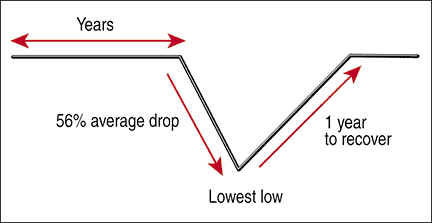CHARTING
Cash In The Air
Cloudbanks
Want to double your money? Invest in cloudbank chart patterns and you just might.
During the 30 years I have spent investing in or trading the markets, I have discovered many chart patterns, including pipes, horns, and barrs. Here’s another, which I call the cloudbank pattern. Investing in cloudbanks gives you the opportunity to make a lot of money if you are patient and price rises back into the clouds.
Identification guidelines
Figure 1 shows an idealized example of a cloudbank chart pattern. It begins with price moving horizontally for several years, but the duration can vary from pattern to pattern. The shortest length in my study was five months and the longest was almost 17 years, with the average duration being 2.75 years. The cloudbank is nothing more than a ceiling of overhead resistance.

Figure 1: cloudbank chart pattern. The idea of a cloudbank pattern begins with years of overhead resistance followed by a swift and significant decline, ending with a recovery that sees price return to the clouds.
The bottom of the cloudbank should have a horizontal base, but often it’s irregularly shaped. By “irregularly,” I mean it is uneven with several valleys approaching the same price separated by large distances. Sometimes, price pokes through the base, but that’s fine. Ignore cloud tops because they aren’t important.
After the cloudbank comes a swift decline to the lowest low that averages 56% for those patterns in which price returned to the cloudbank. Following a V-shaped bottom, price rises, and it takes about a year to return to the cloudbank.
Examples
Often, a bear market causes the drop out of the clouds, but not always. Let’s look at some examples to watch the pattern take shape.